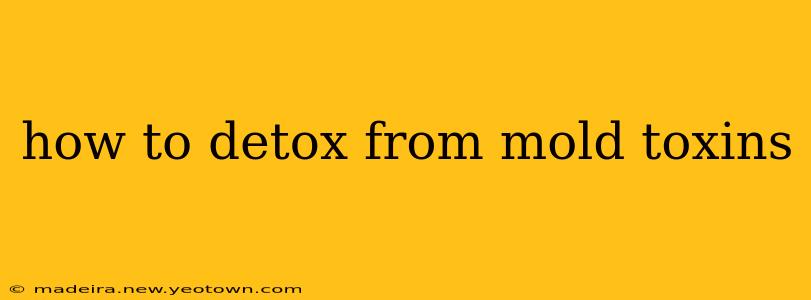Mold exposure can be a silent saboteur, gradually impacting your health and well-being. The insidious nature of mycotoxins—the toxic compounds produced by mold—means that even after removing the mold source, lingering effects can persist. This isn't just about a stuffy nose or minor allergy; significant mold exposure can lead to a complex array of symptoms, often referred to as mold toxicity or mycotoxicosis. This journey towards detoxifying from mold toxins is a personal one, requiring patience, persistence, and a holistic approach.
This isn't a quick fix; it's a process. Think of it like slowly unwinding a tangled ball of yarn—it takes time and careful attention. We'll explore effective strategies to help you navigate this challenging path to recovery.
What are the Symptoms of Mold Toxicity?
Before embarking on a detox journey, it's crucial to understand the potential symptoms. Experiencing one or two doesn't automatically diagnose mold toxicity, but a cluster of these might warrant further investigation with a healthcare professional.
- Persistent fatigue: This is often the first and most pervasive symptom. You might feel drained even after a full night's sleep.
- Brain fog: Difficulty concentrating, memory problems, and mental confusion are common.
- Respiratory issues: Coughing, wheezing, shortness of breath, and recurring sinus infections are frequent complaints.
- Headaches and migraines: Mold toxins can trigger severe headaches and migraines.
- Skin problems: Rashes, itching, eczema, and other skin irritations are frequently reported.
- Gastrointestinal problems: Nausea, vomiting, diarrhea, and abdominal pain can be present.
- Joint and muscle pain: Aches and pains throughout the body are commonly experienced.
How Can I Detox From Mold? A Multi-pronged Approach
There's no one-size-fits-all answer. A successful detox requires a combination of strategies tailored to individual needs. Always consult with a healthcare professional before starting any detox program, particularly if you have pre-existing health conditions.
1. Identifying and Removing the Mold Source
This is paramount. No amount of detoxing will be truly effective if you're still being exposed to mold. This might require professional mold remediation services to thoroughly clean and remove mold from your home or workplace.
2. Supporting Your Liver and Kidneys
Your liver and kidneys are your body's natural detoxification organs. Supporting their function is essential. Consider incorporating foods rich in antioxidants, such as berries, leafy greens, and cruciferous vegetables. Supplements like milk thistle (for liver support) and antioxidants may also be beneficial, but always consult your doctor before starting any new supplements.
3. Improving Gut Health
The gut plays a significant role in overall health and detoxification. A healthy gut microbiome can help eliminate toxins more efficiently. Focus on consuming probiotic-rich foods like yogurt and kefir, or consider a probiotic supplement. Prebiotic foods, which feed beneficial gut bacteria, are also crucial. Think of foods like onions, garlic, and bananas.
4. Hydration is Key
Water is your body's best friend during detoxification. It helps flush out toxins and keeps everything running smoothly. Aim for plenty of clean, filtered water throughout the day.
5. Binders and Chelation Therapy
Some individuals utilize binders, such as activated charcoal or chlorella, to bind to mycotoxins and facilitate their elimination. Chelation therapy, while sometimes used for heavy metal detoxification, is a more advanced and medically supervised process that's not always suitable for mold toxicity. Always discuss this option with your doctor.
What are Some Natural Ways to Detox From Mold?
Many advocate for natural methods, but remember that "natural" doesn't automatically mean "safe" or "effective." Again, consult your doctor before trying anything new.
- Dietary changes: Emphasize whole, unprocessed foods, minimizing processed foods, sugar, and alcohol.
- Sauna therapy: Some people find that sweating in a sauna helps eliminate toxins, but more research is needed.
- Infrared sauna: Similar to traditional saunas, but uses infrared light for deeper heat penetration.
- Exercise: Physical activity boosts circulation and lymphatic drainage, potentially aiding detoxification.
How Long Does it Take to Detox From Mold?
Recovery time varies significantly depending on the severity and duration of exposure. It could take weeks, months, or even longer for some individuals. Patience and persistence are crucial. Regular check-ups with your healthcare provider are essential to monitor your progress and adjust your treatment plan as needed.
What Supplements Can Help Detox from Mold?
Several supplements are often mentioned in relation to mold detoxification. However, it’s crucial to remember that these should only be used under the guidance of a healthcare professional. Self-treating can be risky. Some commonly discussed supplements include glutathione, NAC (N-acetylcysteine), and various antioxidants. Your doctor can determine if these are appropriate for your specific situation and help you navigate potential interactions with other medications.
This information is for educational purposes only and does not constitute medical advice. Always consult with a healthcare professional before starting any detox program, especially if you have pre-existing health conditions. They can help you create a personalized plan that addresses your unique needs and circumstances. Remember, your journey to recovery is a marathon, not a sprint.

